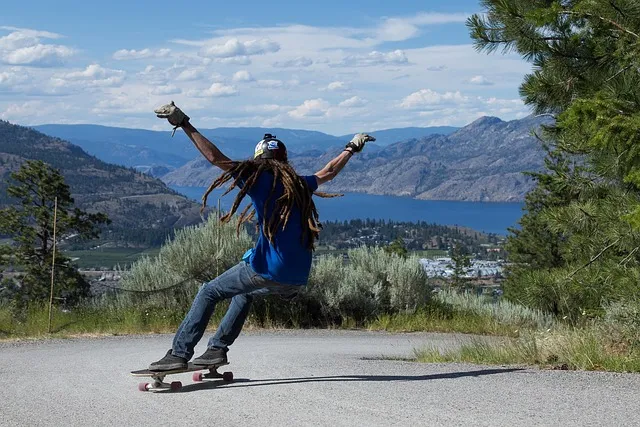For those new to longboarding, especially for long-distance riding, it's essential to start with a longboard designed for beginners that offers stability and control. Mastery of the board's components, such as understanding how trucks and wheels interact with different terrains, is foundational. Basic skills like static balance, footwork, mounting and dismounting, turning, and eventually sliding must be learned on flat ground before tackling longer rides. Safety gear, including a helmet, knee pads, elbow pads, and wrist guards, is non-negotiable for protection against falls and road hazards. Reflective clothing ensures visibility in low-light conditions, and proper footwear is vital for grip and support. Longboard maintenance should be a regular part of your routine to ensure all hardware remains tight and functional, wheels offer a smooth ride, bearings rotate freely, and the deck and grip tape are intact and secure. Strategy in route planning is also important for beginners; opt for flat, well-maintained paths with minimal elevation changes that are not too long to prevent overexertion. By focusing on these elements, a beginner can enjoy a safe and fulfilling longboarding experience that sets the stage for many adventures ahead.
Embark on an exhilarating journey into the realm of longboarding with our comprehensive guide tailored for those eager to conquer long rides. Whether you’re a novice or looking to refine your skills, this article offers a wealth of information on selecting the ideal longboard, essential safety gear, and fundamental techniques to master before you hit the road. From route planning to maintaining your deck, discover how to ensure a smooth, comfortable, and safe experience on wheels. Dive into “Longboard for Beginners: Designed for Long Rides” and transform your longboarding adventures from ordinary to extraordinary.
Understanding the Basics of Longboarding for Beginners

When embarking on the journey of longboarding, especially for those planning to undertake long rides, it’s crucial to grasp the fundamentals. A longboard for beginners is distinct from its shorter counterpart due to its larger deck, longer wheelbase, and typically softer wheels, all of which contribute to a more stable ride suitable for distance travel. As a newcomer to this skateboarding discipline, familiarize yourself with the different longboard styles available, such as downhill, cruising, freeride, and carving, each catering to specific types of rides and terrains. Understanding the configuration of your longboard is also key—wheels, trucks, bearings, and deck shape all play a role in your board’s performance and your comfort during extended sessions. Beginners should focus on mastering the basics, including proper foot placement, balance, and steering techniques. Practice starting and stopping smoothly, as these are essential skills for any longboarder. Additionally, learning to navigate different surfaces and gradients will enhance your confidence and safety as you progress. Remember to prioritize safety gear—helmets, knee pads, and elbow pads are non-negotiable for beginners. As you gain proficiency, you can explore more advanced techniques like sliding, carving tighter turns, and even racing or freestyle maneuvers. Patience and consistent practice will transform your longboarding experience from tentative to thrilling, all while preparing you for those long, exhilarating rides.
Choosing the Right Longboard for Your Riding Style and Needs

When venturing into the realm of longboarding for long rides, selecting the right board is paramount to ensure comfort, stability, and enjoyment. For beginners, it’s crucial to consider the intended use, as different Longboards are designed for various styles of riding. Cruising longboards, for instance, are ideal for their balance between speed and maneuverability, making them a favorite among newcomers. These boards typically feature a more flexible deck and larger wheels, which can handle uneven terrain and absorb shocks from road imperfections. The wheel size and durometer (hardness) play a significant role in the ride quality; softer wheels offer a smoother ride over cracks and pebbles, while larger wheels can maintain speed longer due to their increased rolling resistance.
In addition to the deck and wheel setup, the truck design and bushing selection are also important for beginners. A lower truck hanger angle provides more stability at higher speeds, which is beneficial for those still getting accustomed to the longboarding experience. Bushings, which are the rubber pieces that fit into the trucks, can be adjusted to alter the board’s responsiveness and firmness. Softer bushings offer a looser, more forgiving ride, which can be less intimidating for beginners. On the other hand, stiffer bushings provide a tighter turn, offering precision and control when carving through paths or corners.
Taking the time to research and understand the different longboard types, from drop-through to top-mount designs, will help beginners find a board that suits their riding style and needs. Whether it’s commuting to class, exploring nature trails, or simply enjoying a leisurely ride, the right longboard can transform the experience from daunting to delightful. Always consider factors like deck length, flex, and grip tape to enhance both comfort and safety during your long rides. With careful selection and practice, beginners can quickly progress and enjoy the full spectrum of longboarding’s benefits.
Essential Safety Gear to Ensure a Safe Ride

When embarking on long rides, especially as a beginner on a longboard, prioritizing safety gear is paramount to ensure a secure and enjoyable experience. A reliable helmet is non-negotiable; it should fit snugly, offer full head protection, and have certifications from recognized safety standards. Beyond the head, consider knee and elbow pads, which are essential for absorbing impacts during falls or slides, thus preventing injuries to these joints that are often used to break a fall. Additionally, wrist guards protect against sprains and fractures by keeping your wrists in a neutral position. Reflective gear is also crucial, as it enhances visibility during dawn, dusk, or low-light conditions, increasing your safety when sharing the road with vehicles.
Footwear designed for skating or running will provide the necessary grip and support on your longboard. Make sure your shoes are secure and allow for a range of motion that won’t hinder your control over the board. A high-quality longboard tailored for beginners, with stable trucks and wheels suited to your local terrain, will offer better balance and steering capabilities, contributing to a smoother ride. Always carry a fully charged phone and a first-aid kit in case of emergencies. Incorporating these safety measures into your routine before each longboard session can significantly reduce the risk of injury and ensure a more pleasant experience for beginners exploring long rides on their boards.
Mastering Basic Techniques Before Embarking on Long Rides

For beginners, mastering the basic techniques on a longboard is paramount before undertaking long rides. The initial steps toward proficiency involve familiarizing oneself with the board’s components and learning to balance effectively. This foundational skill can be developed through static balance exercises, where riders practice maintaining stability without moving. Once static balance is achieved, progressing to slow, controlled movements on flat ground prepares the rider for the dynamic nature of riding. Basic footwork and weight distribution techniques are essential for maneuvering on the board and responding to uneven surfaces or obstacles. Beginners should also practice mounting and dismounting the longboard with grace and confidence, ensuring safety and ease when transitioning on and off the board.
Building upon these fundamental skills, novices can then explore turning and carving techniques. Carving, in particular, is a crucial skill for longboarding, as it allows riders to maintain speed over longer distances by smoothly shifting their weight from heel to toe along the length of the board. Learning to turn effectively not only enhances control but also is vital for navigating through tight corners or winding paths encountered on longer journeys. Additionally, understanding how to initiate and control a controlled slide can help riders handle slippery surfaces or sudden decelerations, further preparing them for the challenges of long-distance riding. With these techniques under control, beginners can embark on long rides with greater confidence and safety, ready to enjoy the ride while mastering the art of longboarding.
Tips for Maintaining Your Longboard: Keeping Your Ride Smooth

When embarking on long rides, the smoothness and reliability of your longboard are paramount to an enjoyable experience. For beginners, maintaining a longboard can seem daunting, but with consistent care and attention, you can ensure your ride remains as seamless as possible. Regularly inspecting your longboard’s hardware components, such as nuts and bolts, is crucial for safety and performance. Tighten any loose parts to prevent them from becoming dislodged during a ride. The truck bushings and wheels also require maintenance; hard wheel durometers are often preferred for their ability to glide smoothly over various terrains, but the right bushing setup can fine-tune your turning sensitivity.
To maintain a smooth ride, pay close attention to your longboard’s bearings. Clean and lubricate them at least once every couple of months to remove dirt and debris that could impede their rotation. Additionally, the deck itself should be kept clean and free of cracks. Deck damage can compromise the board’s structural integrity, leading to a hazardous riding experience. Grip tape wear can affect traction; if it loses its stickiness or becomes too worn, consider replacing it for optimal control. By following these maintenance tips, your longboard for beginners will provide a smooth and stable ride, enhancing your long-distance journey immensely. Regular upkeep is the key to a reliable longboard that will support you through the longest of rides.
Planning Your Route: Factors to Consider for Comfortable and Enjoyable Long Rides

When embarking on long rides with a longboard designed for beginners, meticulous route planning is key to ensuring comfort and enjoyment throughout your journey. Consider the terrain of the area you plan to traverse; flat, even surfaces like well-maintained paths or bike lanes are ideal as they allow for a smoother ride. A beginner’s longboard is best suited for such environments, where speed can be modulated with ease, and sharp turns can be navigated without risking a fall.
Route selection also involves analyzing the elevation profile of the area you intend to explore. Steep inclines or declines can present challenges for novice riders, potentially leading to a less enjoyable experience. To avoid this, opt for routes with gradual slopes that are conducive to a longboard’s performance and the beginner’s skill level. Additionally, ensure the route is not excessively long for your first attempt; starting with manageable distances allows you to understand your board’s capabilities and your own endurance limits, gradually increasing both as confidence grows. By carefully considering these factors and planning a suitable route, beginners can embark on rewarding long rides that are both comfortable and enjoyable, setting the stage for a fulfilling longboarding experience.
